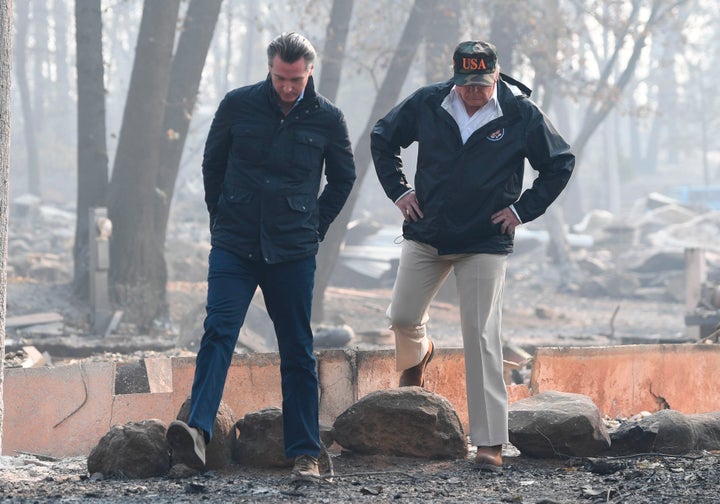Despite a mild summer and rain in the forecast, California state officials are braced for another wildfire season after last year’s fires across the state caused dozens of deaths and the displacement of thousands of residents.
Last year’s most damaging fires ― the Camp fire in Northern California and Woolsey fire in Southern California ― didn’t start until November, and while Californians are grateful for the upcoming rains and cloudy, cooler skies this week, Michael Mohler, deputy director at Cal Fire, said they might not be a cure-all for the typically dry summer heat.
The impending light rains “are not wetting rains,” he said, meaning they won’t significantly reduce any wildfire threats.
“Looking at the next couple weather patterns, we’re still super susceptible,” said Mohler. “Dry fields are still in critical condition, and offshore winds near southern California could mean a wildfire in SoCal.”
While dry fields are the most proximate cause of fires, climate change is perhaps the true culprit. Because temperatures are steadily rising, snow is melting too fast and forests are drying up, creating a recipe for disaster. Wildfire seasons on the West Coast are lasting longer than ever ― in the 1970s, wildfire season was five months long, while now it’s seven. Individual wildfires are also burning through more and more land every year.
Smaller-scale fires have already begun to burn across the state, with the Walker fire in northeast California burning more than 54,000 acres since it started on Sept. 4 (for comparison, the Camp fire had burned through 100,000 acres in just two days). The Tenaja fire in Southern California’s Riverside County burned concurrently, requiring people to evacuate more than 1,000 homes, but it burned through just under 2,000 acres.
“In terms of what we’ve seen for the past 5 years, this [summer] has been mild,” Mohler said. But that doesn’t mean that Cal Fire and Gov. Gavin Newsom (D) are taking their eyes off the weather forecast.
“We have to be prepared statewide at all times,” Mohler said. “We’re still in peak wildfire season.”
“We don’t want people to walk around worried and fearful, but we also don’t want people to get complacent.”
Lessons From 2018
In preparation for this year’s wildfire season, Newsom officially declared a state of emergency in March, calling it “a proclamation that declares an emergency in advance of an emergency.”
“We want to get ahead of this ... before lives are lost and property is lost,” he said.
And according to state officials, Newsom has kept his word.

“Governor Newsom has put a substantial amount of money into the budget to fight these fires,” state Sen. Hannah-Beth Jackson, a Southern California Democrat, told HuffPost on Friday.
Jackson has also spent the last year preparing for fire season. Her district, which includes Ventura County, has been one of the hardest-hit in the state. Last year’s Woolsey fire burned through Ventura and Los Angeles counties, and in 2017, the Thomas fire burned in Ventura County for 40 days.
In response, Jackson drafted two bills aimed at preventing and responding to such fires ― one relating to climate justice and another relating specifically to wildfires. Jackson’s district is about 40% Spanish-speaking, and that community was hit hardest when the Thomas fire started.
“The reporting on the fire was done almost exclusively in English, and the portion done in Spanish was done using Google translation. When we discovered that first responders described it as a ‘hairbrush fire,’ we had some real problems.”
Jackson’s bill requires emergency planning and response efforts to incorporate culturally competent language and to involve interpreters and community members in disaster planning. The bill is awaiting Newsom’s signature.
Jackson has also drafted a fire prevention bill designed to reduce the risk of catastrophic fire damage by banning development in high-hazard areas. She expected some pushback to the legislation, given the need for affordable housing.
“If we are going to build [in hazard areas], it’s going to be critically important that we do so in a way that minimizes the potential for disaster,” she said.
“Take a look at what happened in Paradise — there was only one way in and one way out.”
“We have to recognize that climate change has really created a very, very dangerous situation and we’ve got to be able to step up and meet it.”
- State Sen. Hannah-Beth Jackson
More than 80 people died as a result of the Camp fire last year, and most of them were from Paradise. The Camp fire was particularly horrific because of the limited infrastructure in place to escape the city while it was burning at insanely high, wind-driven speeds. Residents abandoned their cars and belongings to run from the fire on foot, carrying children and pets and hoping they would make it out alive.
“We really need to start planning better in these kinds of events,” Jackson said. “We have to recognize that climate change has really created a very, very dangerous situation and we’ve got to be able to step up and meet it.”
Mohler and Jackson both applauded Newsom’s commitment to being better prepared this year.
Newsom added 400 seasonal firefighter positions to Cal Fire, 13 new fire engines and a Black Hawk helicopter capable of carrying 1,000 gallons of water or fire retardant.
Newsom invested in emergency preparedness, Mohler said, “and we’re seeing a return on investment.”
CORRECTION: A previous version of this article misstated the amount of water the Black Hawk helicopter is capable of carrying. The piece has been updated with the correct amount.
